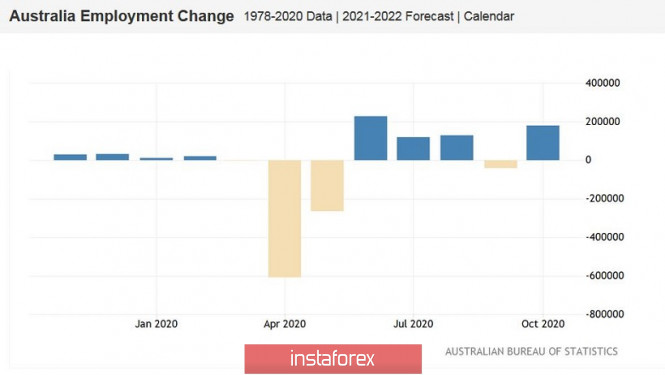The Australian dollar reacted very cautiously to the strong labor market data, which was published during the Asian session. The reason for this is COVID-19, which stresses AUD/USD traders again. Despite successful development of vaccines against the said virus, COVID-19 is still exerting massive pressure on the AUD. The new quarantine restrictions, which is affecting South Australia this time, may slow down the economic recovery of the country again. In view of this, previous macroeconomic successes do not look so relevant anymore. And although the country also had quarantine restrictions throughout October, it can still be seen that the Australian labor market coped quite well with the challenge and even showed some achievements.

According to general forecasts, October's unemployment rate was supposed to rise to 7.2% (from the previous value of 6.9%), but it grew up to 7% only. The growth of employment data also certainly did not justify the analysts' pessimistic forecasts. Last month, the indicator fell into the negative zone for the first time since May this year, when Australia was at the peak of the coronavirus crisis. And according to experts' expectations, this indicator was also supposed to show negative dynamics, which is expected to decline by 29 thousand. However, it turned out the other way around: the indicator rose, reaching 178 thousand. This is the strongest growth rate since June this year, when Australia began to lift lockdown.
It should also be stressed out that the growth in the employment rate was not solely due to the growth of part-time employment. The full-time employment data also increased by 97 thousand, while the partial one was by 81 thousand. We believe that the number of full-time positions will have a positive effect on the consumer activity of Australians in the future, as well as on inflationary processes. Therefore, today's result is also positive in this aspect. It is also noteworthy that the share of the economically active population has grown to 65.8%, which is the best result since March this year.
You should bear in mind that the values published today cover the period from the end of September to the second half of October. At the same time, the Australian authorities announced last October 26 that Melbourne could gradually come out of quarantine. There were severe restrictive measures and even a curfew prior to that. The lockdown in Melbourne was extended several times – in total, it was in effect for almost four months.
During this time, all shops, restaurants, cafes and bars were closed, and sports were only allowed outdoors. The economic consequences of the tightening of quarantine were reflected not only at the local level. For example, problems arose with the supply chain, since this region is the location of the largest container port in the country. In other words, the coronavirus crisis in this State has affected the whole country, but the labor market has shown a very good result amid such restrictions in the largest region of the country.

The AUD only impulsively surged to the borders of the level of 0.73 and went back almost immediately, despite the fact that one of the key macroeconomic releases came out in the "green zone". The Australian Nonfarms did not become a catalyst for the growth of AUD/USD pair, although all the prerequisites for this were. The blame is on COVID-19, which closed one of the country's States again and this time, South Australia.
There was not a single case of COVID-19 recorded there for six months, but a few days ago, the virus was found in 36 people at once. Therefore, the local authorities reacted right away – the almost two million region was closed for at least a week. Moreover, people were ordered not to leave their homes (including for jogging), all schools and universities, restaurants, cafes, shops (even without the possibility of ordering food "to go") were closed, masks were introduced in public places and long-distance travel was banned. After a tough six-day quarantine, authorities plan to practice lax restrictions over the next two weeks, gradually emerging from a complete lockdown.
Such news defeated the Australian dollar's position. Therefore, the corrective pullback of the AUD/USD pair can be quite massive. The pair is expected to decline up to the base of the 72nd figure, particularly to the support level located at 0.7220 (upper border of the Kumo cloud on the daily chart). And although long positions are still relevant in the medium and long term, it is not suggested to buy in the near future, since there is a risk of drawdown. If the indicated pair slows down and/or drifts at the bottom of the 72nd figure, longs will be in priority again, with the main goal of 0.7300.
The material has been provided by InstaForex Company - www.instaforex.com